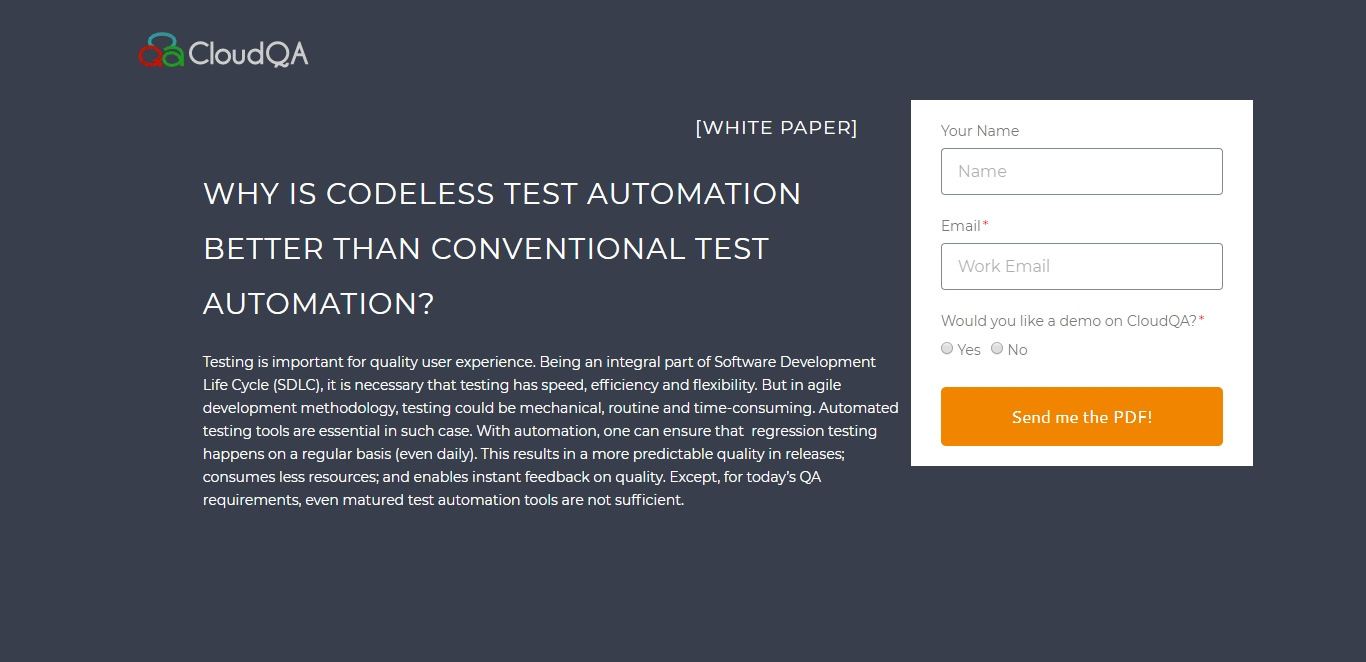What is the ROI of your test automation?
Test Automation is a strategic decision influenced by myths and facts. However, firms need to understand any test automation is an investment, which has its assumptions and a strategy, stressing the need to measure the ROI. But what are the factors that influence ROI? Are there any assumptions? Is there a formula to devise? Are there any tools like Test Automation ROI Calculator? Is there a range that dictates my test automation suite is healthy once ROI is calculated? To these questions and more @CloudQA is here to help you.
What is ROI of Test Automation?
Most of the ROI calculator available online uses a simple formula = hours saved via automation multiplied by an hourly rate.
But we haven’t included the expense to purchase automation tools, learn scripting language, or hire new resources, software, environments, etc.? Hence the above formula does not provide you with accurate results. So, let’s list down all the factors that could affect an ROI of test automation suite.
Factors Affecting ROI of Test Automation
Some of the factors that influence the ROI of test automation are –
- Test Automation Tool License cost
- Number of test cases that could be automated
- Time and Cost involved in initial designing of automation framework, feasibility and reskilling of team
- Per hour cost of Automation Engineer
- Number of builds/releases per year
- Average number of test cases in each build
- The configurations and regression cycle of each build.
- Hardware, Software and other miscellaneous cost
- Product Stability
Once we have these vital stats, ROI calculation would be easy. Let’s pick an example, based on a testing project here are some numbers –
| Number of builds every week | 1 |
| Number of test cases per build | 250 |
| Cost of Automation tool [1-50 users] [One year validity] | $10,000 |
| Manual Tester hourly service rate | 80$ |
| Automation tester hourly service rate | 100$ |
| Manual Effort per week | 8 hrs |
| Other hardware Cost [Machine/Mouse/etc] | $500 |
| Time to automate one test case | 1.5 hrs |
| Miscellaneous Activity [Starting the script, maintenance, etc.]/per week | 10 hrs |
| Test Case documentation [single test case] | 45 minutes |
| Time to manually execute one test case | 15 minutes |
| Costing in training | $15,000 |
Considering a release every three months i.e. four test cycles.
| 1st Year[3 months /1st cycle] | ||
| Automation | Manual | |
| Tool Cost | 26,000 | 0 |
| Cost of designing | 450000 | 180000 |
| Cost of test execution | 0 | 60000 |
| Maintenance Cost | 12000 | 0 |
| Total | 4,88,000 | 240000 |
| ROI | -3.33 % | |
| 1st Year[9 months /2nd/3rd/4thst cycle] | ||
| Automation | Manual | |
| Tool Cost | 0 | 0 |
| Cost of designing | 0 | 0 |
| Cost of test execution | 0 | 180000 |
| Maintenance Cost | 36000 | 0 |
| Total | 36000 | 180000 |
| ROI | 180% | |
Please note that the figures above are just for illustration and may vary with each product, geography, and tool.
Advantages of ROI Calculation
- A firm knows if the effort and money used by the Automation team are paying off or not
- Efficient test coverage.
- Enhanced product quality
- Feasibility of Quick execution in multiple environments
- Focus on results and process improvements
ROI is not only about a long term investment reaping benefits, but it also assures quality and that should be the primary goal of any firm with ROI or without it.
LIKE THIS POST SHARE IT WITH YOUR FRIENDS
RECENT POSTS
Guides

How To Select a Regression Testing Automation Tool For Web Applications
Regression testing is an essential component in a web application development cycle. However, it’s often a time-consuming and tedious task in the QA process.

Switching from Manual to Automated QA Testing
Do you or your team currently test manually and trying to break into test automation? In this article, we outline how can small QA teams make transition from manual to codeless testing to full fledged automated testing.

Why you can’t ignore test planning in agile?
An agile development process seems too dynamic to have a test plan. Most organisations with agile, specially startups, don’t take the documented approach for testing. So, are they losing on something?

Challenges of testing Single Page Applications with Selenium
Single-page web applications are popular for their ability to improve the user experience. Except, test automation for Single-page apps can be difficult and time-consuming. We’ll discuss how you can have a steady quality control without burning time and effort.

Why is Codeless Test Automation better than Conventional Test Automation?
Testing is important for quality user experience. Being an integral part of Software Development Life Cycle (SDLC), it is necessary that testing has speed, efficiency and flexibility. But in agile development methodology, testing could be mechanical, routine and time-consuming.






